-
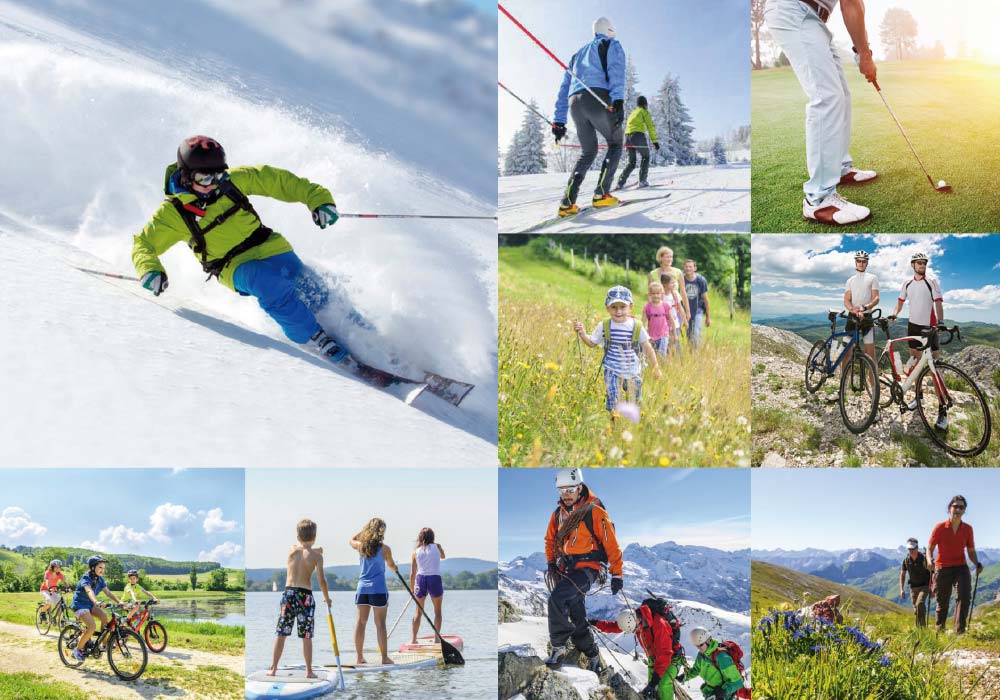
SPORT & FUN
Around the year top athletes, as wells as family and friends acquire a taste for experiencing something new, when it comes to SPORT & FUN. Our exquisite mountains and the many lakes nearby offer numerous sport activities. Be it mountain biking, hiking, rock climbing, sub boarding, swimming or golf, skiing, backcountry skiing, sledding or ice skating – these are only a few sport activities, for we cannot name all of them, nor picture them - our space would be too little! Try them all out, we would recommend!
-
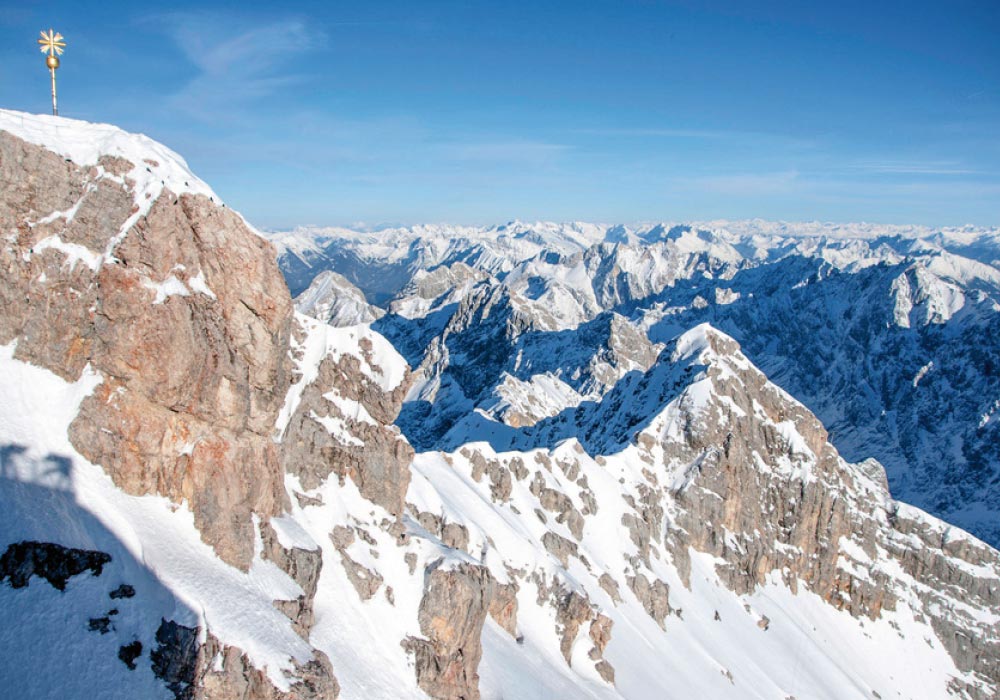
THE ZUGSPITZE
With its 2964 Metres, the Zugspitze is the highest mountain of Germany. Apart from hikers who climb it on foot, you can reach it by train from the “Zugspitzbahnhof”, behind the main train station. Or, quite adventurously, you can take the cable car from the “Eibsee” at Grainau. Not only in the summer, the Zugspitze is a grand place to visit, with a view into 3 countries, but also in winter the mountain is guaranteed to have snow with slopes for skiing all levels of difficulty, from the beginner to the top skier. Equipment can be rented on top. Huts and sun terraces invite to linger, to eat Bavarian food and bathe in the sun. There is also an Igloo village with ice sculptures, a hotel made out of snow and ice.
-
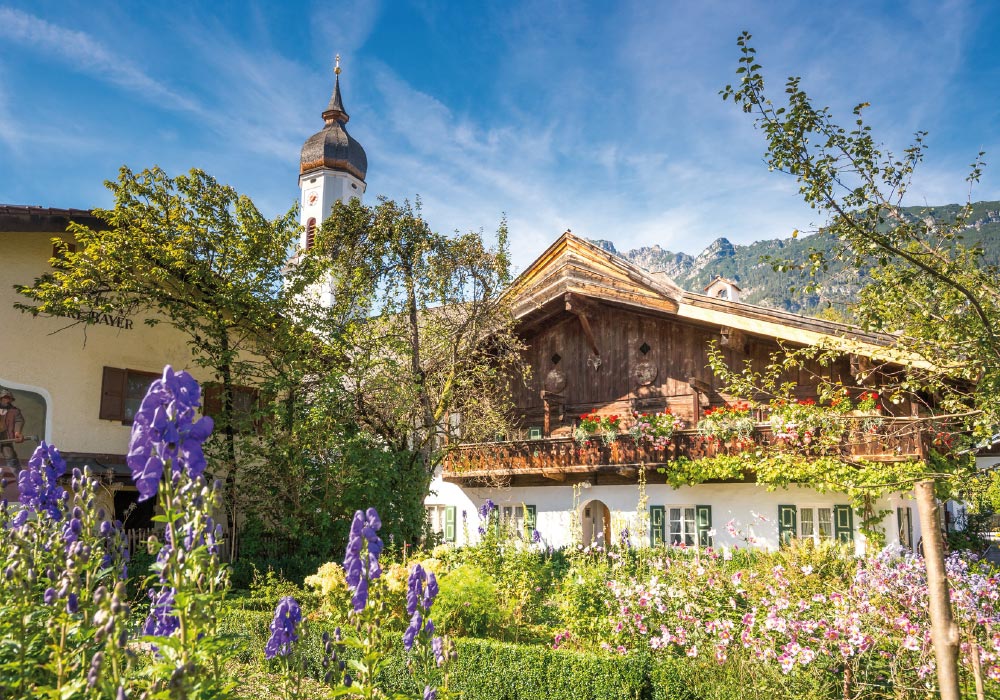
THE PEDESTRIAN ZONE IN GARMISCH
A shopping and strolling area that you will like! Cafés and restaurants for indulging in fine cake and food, Bavarian clothing, boutiques and shops of all kind. On our image you see the „Polz´n Kasper Haus“, an ancient Bavarian house, built 1740, with a typical Bavarian “farmers garden”, displaying traditional flowers and plant variety.
-
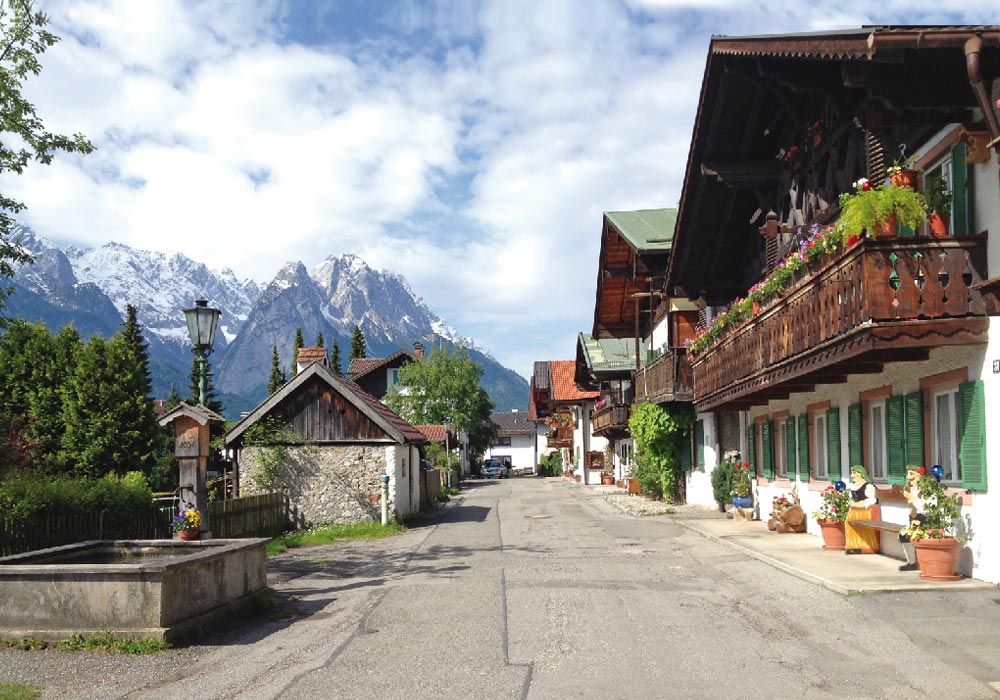
FRÜHLINGSSTRASSE AND SONNENSTRASSE IN GARMISCH
The most famous street in Garmisch is the “Frühlingsstrasse”. But also the “Sonnenstrasse”, parallel to it is a sight to be seen. Both streets, with its over hundred year old houses, remind us how the ancestors lived all those years ago. Picturesque and ethnic, they tell a story of their own. In the same area you will find many houses with traditionally painted images, the so called “Lüftlmalereien”. The nearby “Bräustüberl” with its beer garden and the “Husar” are restaurants you will certainly enjoy.
There are guided tours in English around Garmisch-Partenkirchen and its history: www.gaestefuehrer-garmisch-partenkirchen.de
-
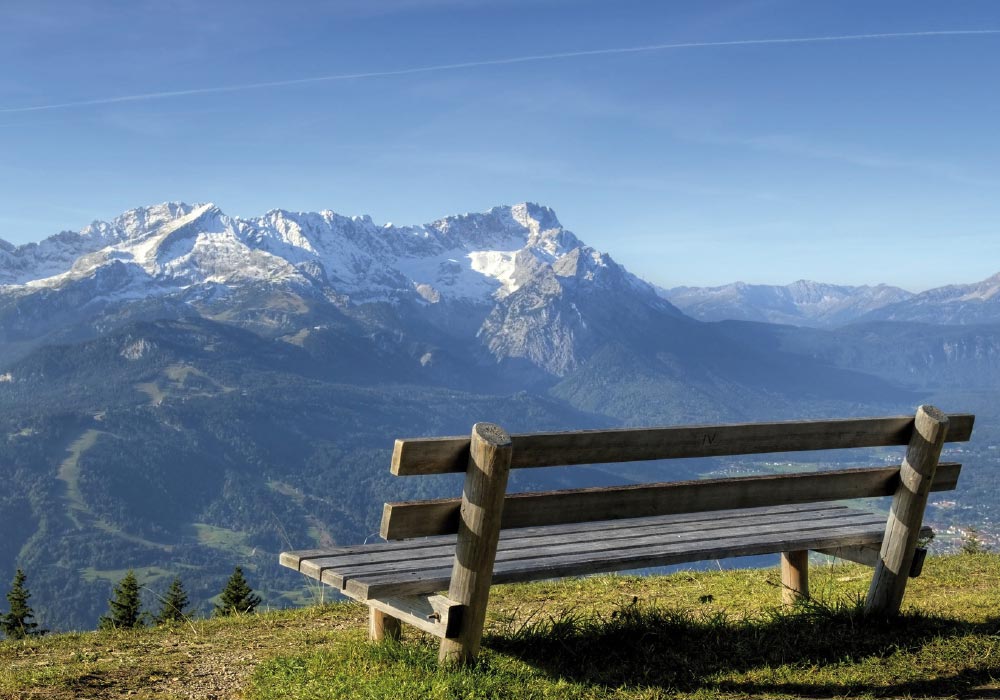
THE WANK
The Wank is called the “sun mountain” by the local. With its 1780 metres it lies exposed in the “Estergebirge” (Ester mountains). The view reaches to all mountains in its surroundings and down to Garmisch-Partenkirchen, the Loisach valley and to the borders of Munich. A plant variety with gentian, alpine rose and mountain pine complete the picture. Loop pathways with sun terraces made out of wood invite hikers to linger. With the cable car one can reach the top and who fancies it, can hike down via various routes. Of course there are huts for a bucolic stop. In the winter time the Wank is an Edoroado for snowshoeing and backcountry skiing.
-
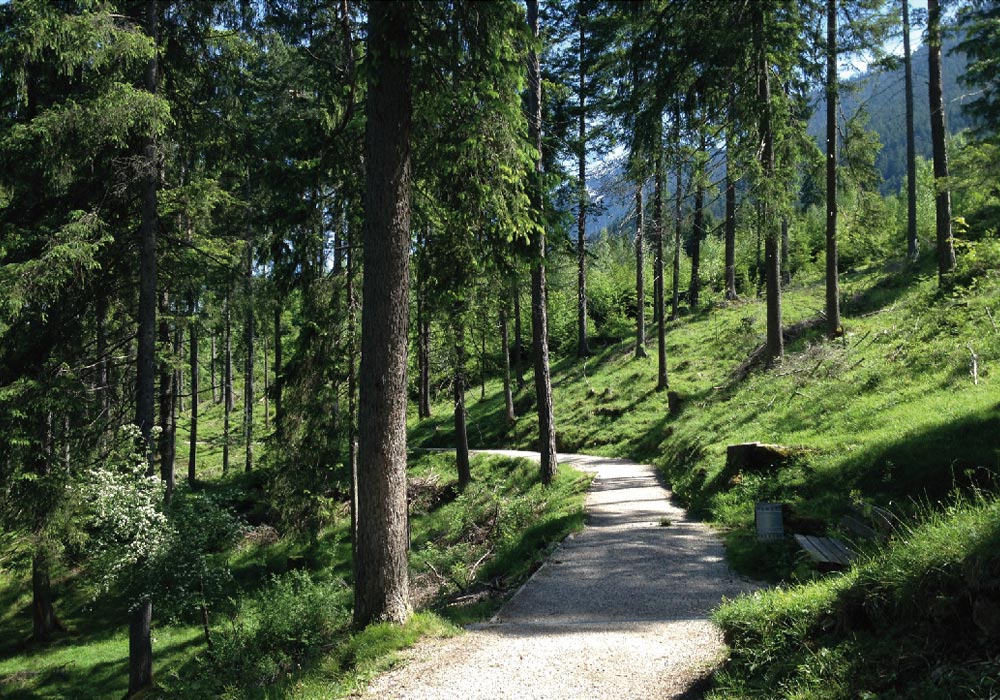
THE "PHILOSOPHENWEG" AT THE WANK
Those who want to reach the top find endless varieties of routes to hike the mountains, but guests who would rather walk on more even pathways in the valley with inns nearby also find their perfect promenade. One of those is the “Philosophenweg”. From the little Church “St. Anton” it leads to the town Farchant. Alongside one finds numerous seating benches with quotations of famous philosophers. The path is very romantic and can be even driven by a wheelchair. It is cleared from snow in Wintertime and a special tip for Joggers, Nordic Walkers and amblers.
-
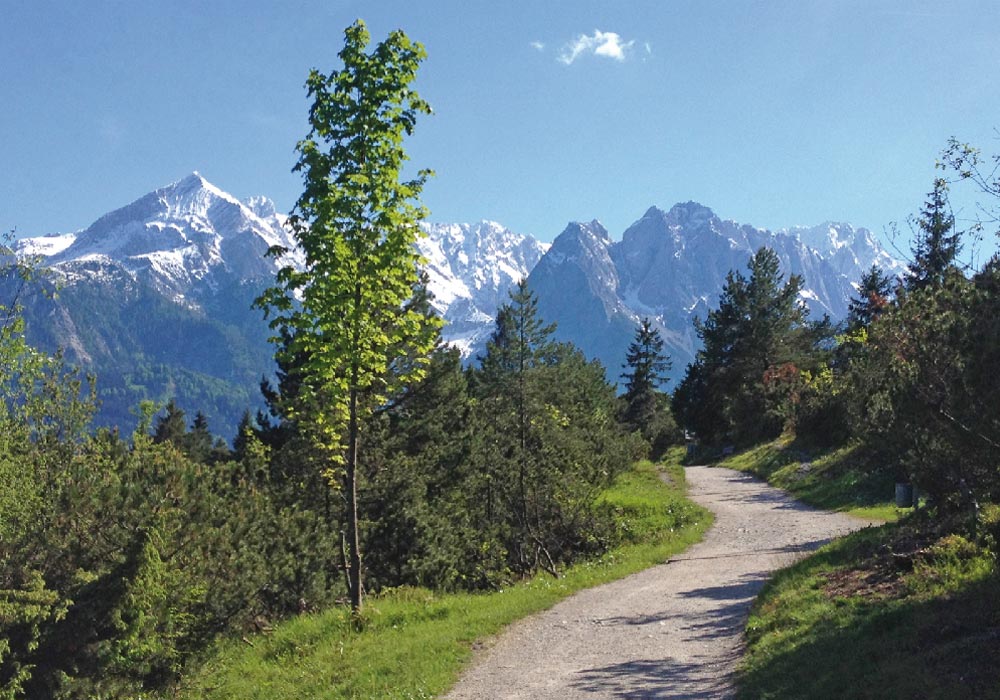
THE KRAMERPLATEAUWEG
Along the Kramer, one can stroll along the beautiful “Kramerplateauweg”, a path starting from the restaurant “Almhütte”, which is also called the “Windbeutel Alm”, named after a famous dish that is served on its sun terrace with a spectacular view. One can drive up by car and then venture out towards the “Pflegersee”, a lake with a restaurant. In the other direction the path leads to Grainau.
In the wintertime one can watch the feeding of wild game near the “Almhütte” in the late afternoon. A rare opportunity to see red deer so close. Approximately in the middle of the path a chapel dedicated to the war victims oversees the valley. Above it, a windy path leads up to the “St. Martins Hütte” (an inn), in winter a fine sledding route and in summer a popular destination with a grand view into the valley.
-
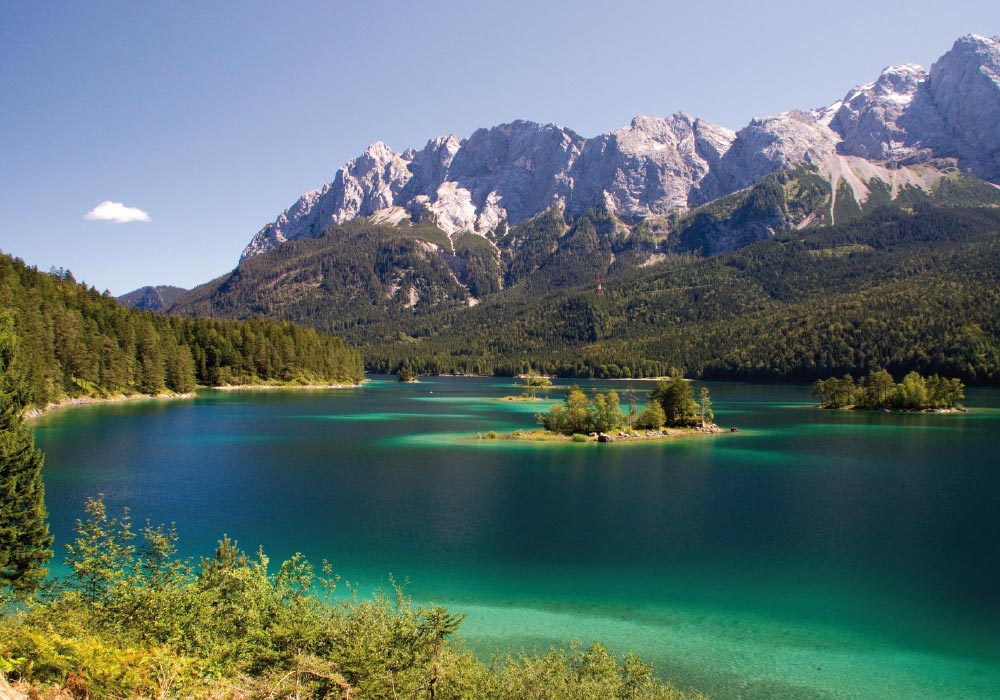
THE "EIBSSEE" BY GRAINAU
Just underneath the majestic Zugspitze one finds the “Eibsee”, a beautiful lake, with its turquoise coloured water like a precious stone from a fairy tale. To hike completely around it, takes 1,5-2. On its shores you find a public swimming bath, a boat rental, the Eibsee Hotel and a snack bar.
From the east shore one can watch the cable car going up to the Zugspitze (2964m). The Gondola station and the stop of the “rack and pinion railway” are right above the parking lot of the lake. In summer the lake is popular for swimming, but its atmosphere and mountain view is a feast for the eyes in every season.
-
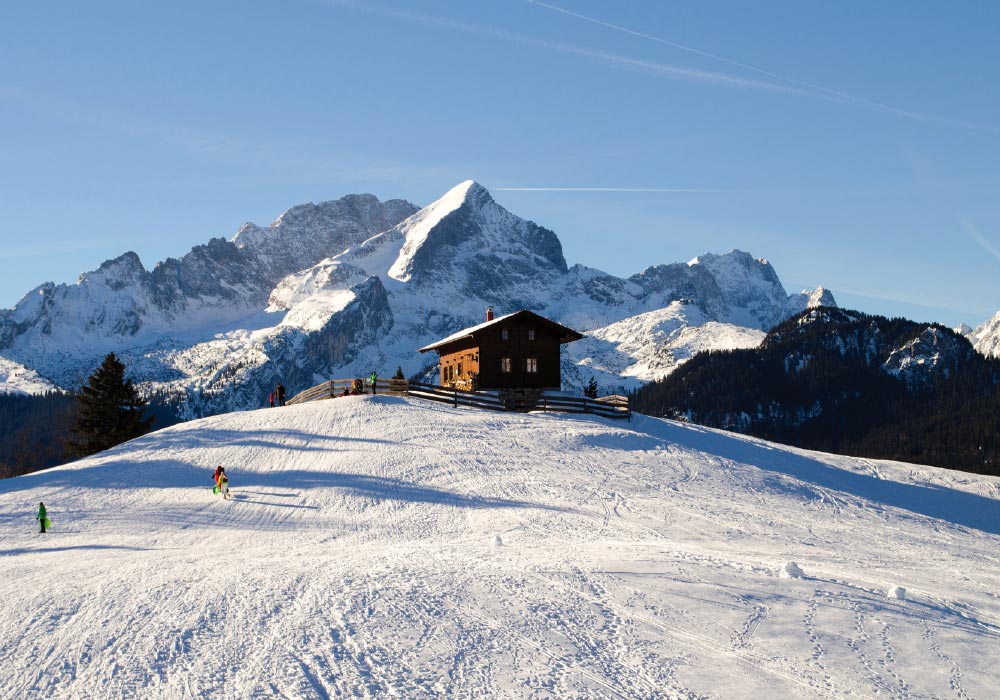
THE "ECKBAUER"
Right next to the Ski jumps, a historic gondola takes you up to the “Eckbauer” (1236m). Along the ridge, wooden benches invite lingering to a grand view of the “Wetterstein” mountains, the “Alpspitze” and the “Reintal”. One can go back down via the gondola or hike down to Wamberg, Germanys highest church town (1000m) with 27 inhabitants and an inn with a sun terrace. The amazing “Partnachklamm” can be reached in 45 minutes and whoever fancies to visit Schloß Elmau via the Elmauer Alm is there in 1.5-2 hours. A great day tour. In winter a sledding route leads down the Eckbauer; at its foot you find a summer toboggan-run.
-
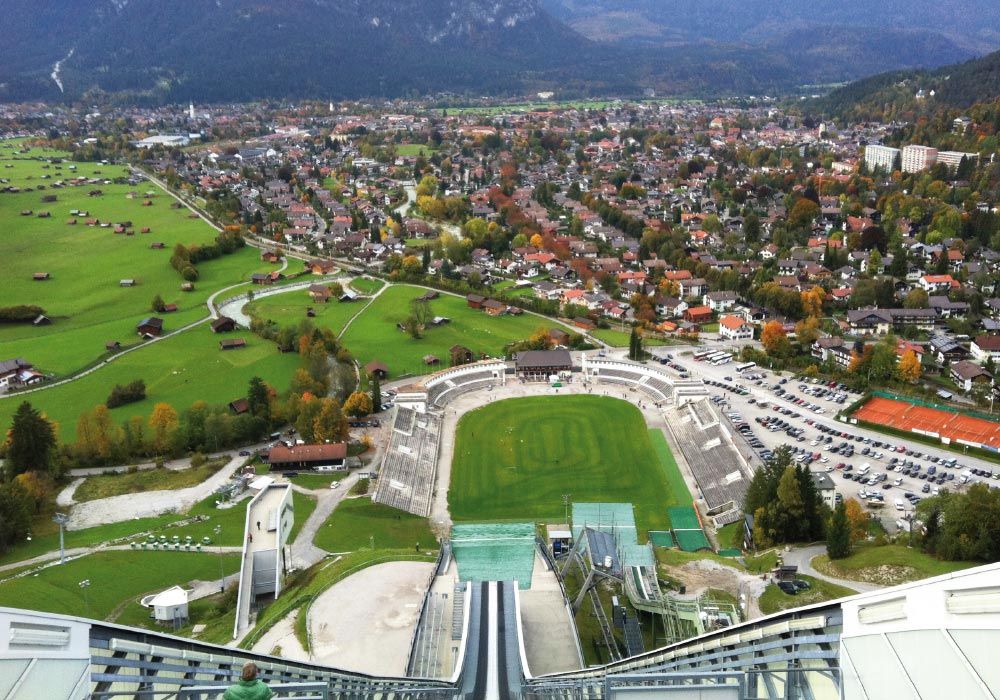
THE SKI JUMP
At the foot of the Eckbauer, on the “Gudiberg”, resides the Olympic Ski Stadium with its grand Ski Jump. In the course of the Four Hills Tournament, every year on the first of January, the legendary New Years Jumping takes place. The first jump was built in 1923. 2007 the grand Ski Jump was built anew, 62 metres high and suspended in the air with an inrun tower of 100 metres length. Conducted tours take place on Saturdays at 15.00 o´clock, with a minimum number of 8 persons. The Stadium itself is worth visiting with its fantastic exhibition “The dark side of the medal”, revealing the triumph as well as the dark side of the Olympic games in 1936. Located near the Stadium is the “Kainzenbad”, a natural swimming pool with its jumping towers, small children´s pools and its large grassland areas with shady chestnut trees. It is the perfect place for a family in the summer time.
-
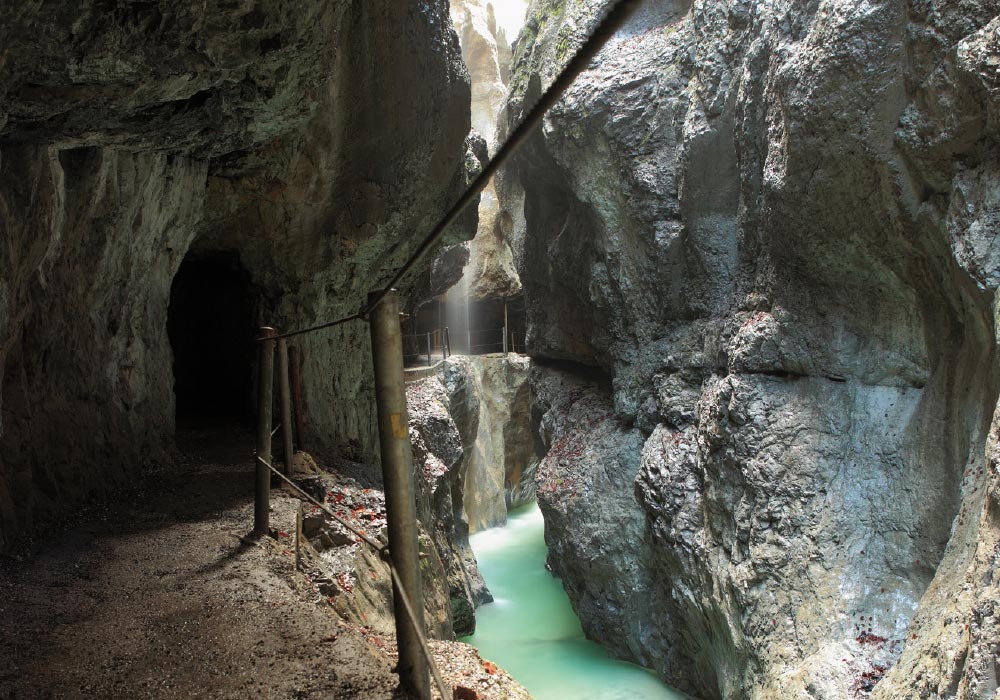
THE PARTNACH GORGE
From the Olympic Skistadium a 25 minute-hike or a romantic horse-drawn carriage (the “Fiacker”) takes you to the entrance of the “Partnachklamm”, a wild, romantic and dangerous gorge with brawly waters and turquoise pools. In the old days men drove wood down the gorge under life threatening conditions.
Today you can visit the gorge safely. Comfortable pathways lead you along the wild waters through dripping tunnels and dents. We recommend hiking boots and a raincoat. In winter and in summer there are torch-lit tours though the gorge. From its top many walks lead into the Wetterstein mountains and into the Reintal.
-
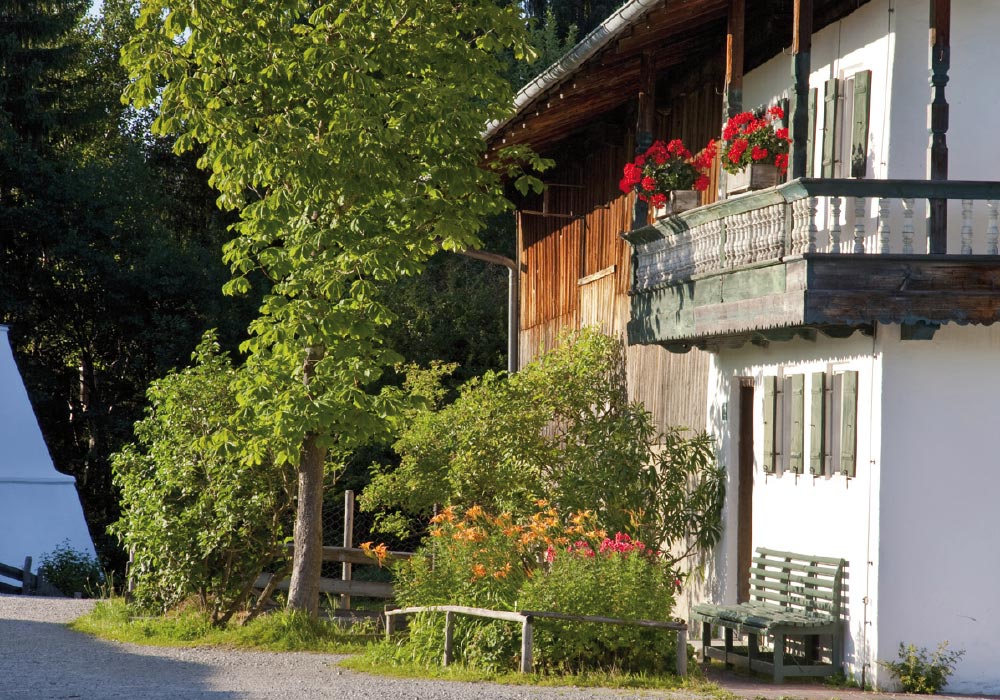
THE "GELENTLEITEN MUSEUM" – A FAMILY EXPERIENCE!
The outdoor Museum “Glentleiten” allows an extensive insight into the rural every day life of the inhabitants of Upper Bavaria, into their building culture and working world. More than 60 original preserved farm buildings including their furniture have been re-constructed after historic models in the midst of their cultivated man-made landscape. For families and culture lovers a wonderful daytrip. The kids program is very popular. “Join in” seems to be the motto. Detective “Hirnzwicker” gets the children to resolve a tricky criminal case! Handicrafts of old are demonstrated. The versatile program goes from embroidering the braces of “Lederhosen” to silversmith work and jewelry. You also find a historic corner shop and a Bavarian inn. (www.glentleiten.de)
-
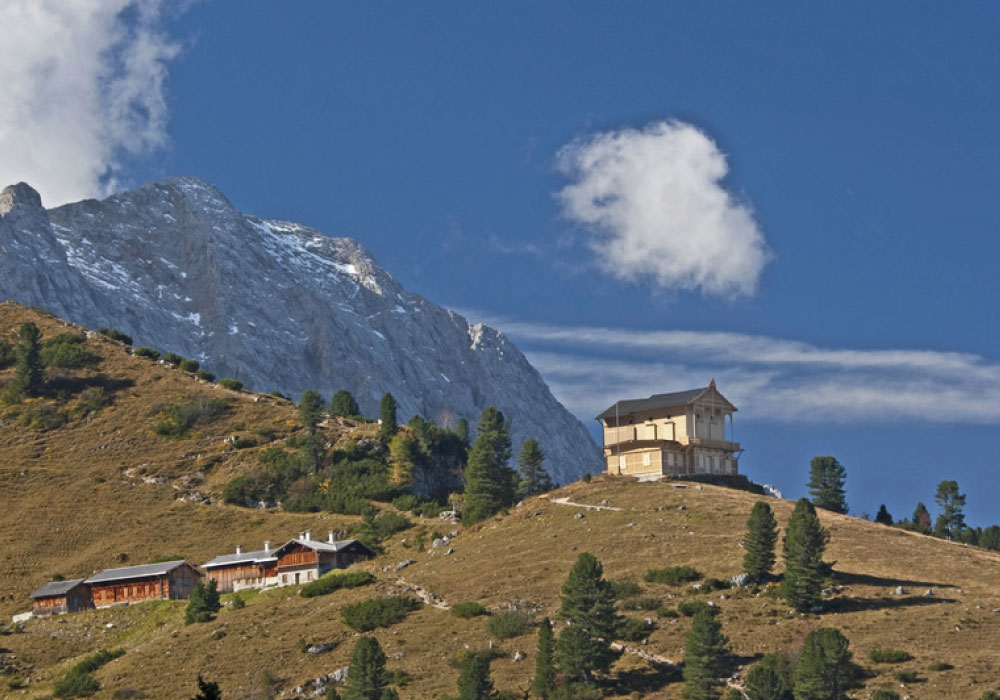
THE SCHACHENSCHLOSS
Since 1869 King Ludwig II planed to build a mountain home in the county of Werdenfels. For its location he chose the “Schachen” at the foot of the Wetterstein mountain, 1866m high, isolated and with a fabulous view. The castle was built out of wood in the style of a “swiss house”. The five rooms on the ground floor are comfortable and panelled with swiss cone pine. On the top floor, however, one faces oriental grandeur: a historic hall, inspired by the palace of Eyüp, which was built by Sultan Selim II at the end of the 18th century. A pompous saloon with gold coated, richly ornamented walls, a water fountain, richly embroidered stools and divan beds, precious carpets and large colourful ornamented window glass – exotic ambiance in 1866m!
-
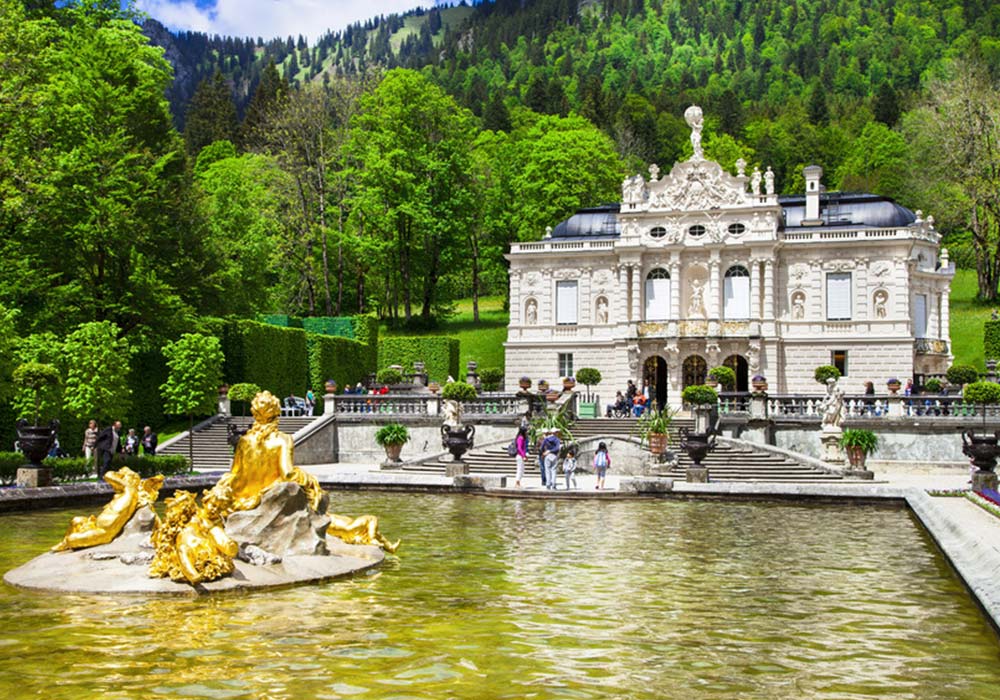
SCHLOSS LINDERHOF
The castle is the only one of his castles that King Ludwig II. (1845–1886) could compass in 1878. It is rather small and reminds one of a French pleasure palace. In it, dreams come true: Swans, islands, grottos, shells, peacocks, mirrors, flambeaux, coruscating saloons and grandiose mirror halls revive the grand style and affluence of its class. The arts and craft quality is incomparable. One main feature is a “table which sets itself”. The table would arise from the floor below via an elevator (a flagrant novelty in this time), set with dinnerware and fine foods, for the king preferred to dine alone. He was a lonely man and all that he had built was made for himself only - his child eyes.
-
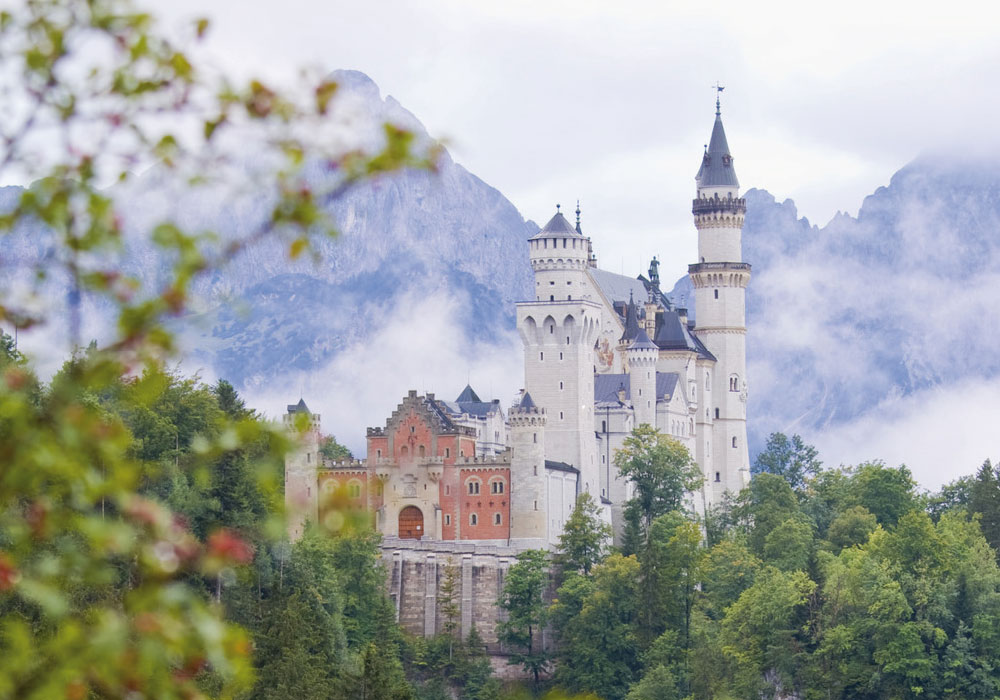
SCHLOSS NEUSCHWANSTEIN
A fairy tale castle – a children´s dream come true – broad pinnacles, high towers, steep rocks in the midst of blue mountains. “Neuschwanstein” is not a copy of a middle age castle, but a characteristic of its time called Historism. You find many motives from Richard Wagners opera such as „Tannhäuser“ and „Lohengrin“. The bard halls paradigm was the ballroom of the “Wartburg” by Eisenach and its mural paintings picture the saga of Parzival. Splendiferous and magnificent is the castle, the very castle where King Ludwig II. lived out his last days of freedom. Wherever this king built – 100 years later it became a highlight, a pearl in the landscape, a fairy tale for grown up children.
